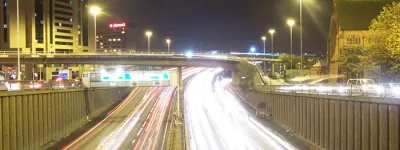Any brief account of Britain's pedestrian crossings will tell you that the Panda Crossing was a failure that was ditched in favour of the Pelican Crossing. But things are never quite so simple. Created in 1962, Panda Crossings might not have been popular or intuitive, but they flashed and pulsated their way across much of England before they were supplanted by something new. It wasn't until 1967 that the Ministry of Transport unveiled the Panda's successor. It was called the X-way.
The name "X-way" was a direct reference to its distinctive white cross for drivers, which the Ministry referred to either as the St Andrew's Cross or the Saltire. The name was meant to be pronounced "crossway", to go with "motorway", "subway" and other road-related ways. The choice of a white cross symbol was, of course, simply because it marked a place to cross. But the connection between a "crossing" and the "X" seems to have passed most journalists by, and it was usually taken as being an X for the sake of an X. Most referred to it as "the new 'X' crossing", or something similar, which was of course quite meaningless.
The new X-way was launched in, of all places, Lincoln High Street, on 7 March 1967, nearly five years after the Panda. The Mayor of Lincoln, Councillor F.R. Eccleshare, was the first to use it, an honour that his family probably recall with fondness to this day.
The Sheffield Morning Telegraph reported that Lincoln's coroner was not quite so pleased. "They are over-complicated and there has been a lack of explanatory literature," he thundered. "In time local motorists will understand them, but strangers from places where they are not in operation will be utterly confused." This was a local crossing for local people, evidently. Luckily, the City Engineer stepped in to save some face, claiming that "they are going to be successful and one day they may replace zebra crossings everywhere."
Unlike previous types of crossing, which had just been replaced as their useful life ran out, the Panda Crossing had been enough of a disaster to warrant complete and immediate removal. All of England's Pandas were replaced very quickly with new X-ways — effectively exchanging one experiment for another. The X-way was received with much more enthusiasm however; as early as February 1967 Glasgow had registered its interest in installing them by the wheelbarrow-load, and Leeds (ever the pioneer) had declared that it was going to install them on enormous gantries on two of its main city centre streets, Briggate and Vicar Lane*. It's hard to ignore the possibility that local authorities didn't like the Panda and were waiting for the government to let them use something more like the old signalised crossings of the 1930s and 1950s, which might not have had an exciting name like "Panda" or "X-way", but were at least successful.
* The gantries survived until the mid-1990s, a series of battleship-grey eyesores on the city's main shopping streets, though by that time they had long since been converted to outsized Pelican crossings.
